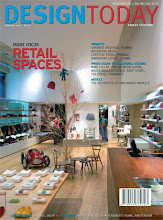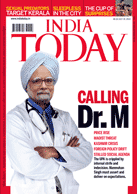(Vol-3 No-6 Newsletter of Design For All Institute of India, June 2008)
..............................................................................................................................


..............................................................................................................................

For quite sometime now I have been deeply intrigued by the everyday mundane objects lying all around us. The market is flooded with a plethora of redesigned products but very few redefined objects.
When one re-designs a product, one tends to retain the essence of it’s being…the soul.
However gives its body a complete make over…without even hitting on the mind.
When we re-define, as the word itself suggests, we work on the soul of the product, we question its very existence. Thus, giving the product a new mind and a fresh body.
Body attracts!
A beautiful body is as important as a beautiful mind.
An aesthetically balanced product drives the customer close to itself. “Form-material” relation is one of the demanding parameters of a good-looking product. It makes it desirable.
Color adds the oomph factor!
Mind is that aspect of the product, which interacts with the user/customer.
Sometime it directs the user to handle the product in a particular way and sometime it doesn’t.
(context: democratic design!)
Soul is the essence of its being, its purpose, satisfying the user’s wants/needs.
It brings about the WOW! Factor. A good product is which is a perfect balance of BODY – MIND - SOUL.
Everyday products, they are so numerous and ubiquitous as to be frequently taken for granted. Yet they form the material framework of our existence, enabling it to function, not only in practical or utilitarian terms, but also in ways that give pleasure, meaning and significance to our lives.
I believe in voluntary simplicity. It is about freedom. It is about wanting less. It permits one to spend less time on innovating features (which land up adding clutter) and more time bringing in new experiences, insights, and relationships between the product and the user. It is rather difficult to say much about my approach towards design, but I have a fascination for monolithic, mono-colored ‘organo-mathematic’ forms and whatever needs I have felt and observed I have tried to translate them into products.
Redefining something as ubiquitous as the clothes line clip was a risky thing. It is one of the few rare objects whose integrity, practicality and sense of purpose has remained intact over the years. Although various shapes and materials have been explored, none have an emerging brilliance of a perfect match of form and function.
‘Clip’ is the manifestation of my imagination of a world with interesting artifacts…which not only look good but also have a definite function to perform.
I call it - utilitarian design.
To whatever modern life style we adapt to…the need for clothes peg would still be there…especially in India. But as we are moving toward more and more eco-concerned social structure…the need to think of green design has taken the front seat. The basic aim of my design was to create a single piece product with recycled plastic with no metal components.
:Integrity of purpose:
It is a cloth line clip to be used as a daily life utility product for both indoor as well as outdoor application. Clip fulfills more than it promises – not only in use, but the perceived pleasure is far than expected.
:Technical Uniqueness:
The product is a single piece injection molded component in recycled plastic with reduced number of components. Its primary innovation is the possibility of being hanged by both of its extremities. Hence, the user does not need to check the jaw side every time he/she is hanging the laundry. Moreover, one needs to only slide this clip over the cloth, hung on the line, and does not require applying any pressure. The geometry of the Clip + the flexibility of the material (LDPE) allow it to do so. This attribute is of great help to the aged / arthritic people.
The fundamental configuration of the common cloth line clip has been altered in this design.
In the ordinary clips, the clamp and hinge goes parallel to each other where as in this case the area (surface) which is holding the cloth and the area (cross section) which is acting as hinge is perpendicular to each other, which acts as a stiffener.
It leaves no rust marks on clothes, as there is no metal component.
:Advantage by design:
How does it stay in one place and not slide along the washing line?
It is intended that they slide over the garment and cloth line, rather than open and close spring-like as most clips do.
Regular clips cling tightly onto the cloth as well as the line. Hence they are always under stress-strain situation. However, the Clip, which I have designed, rests in equilibrium once it has been slid onto the line. Hence more stable and more durable, apart from having a dual jaw which increases its life two folds.
Regular clips cling tightly onto the cloth as well as the line. Hence they are always under stress-strain situation. However, the Clip, which I have designed, rests in equilibrium once it has been slid onto the line. Hence more stable and more durable, apart from having a dual jaw which increases its life two folds.
During any heavy wind flow, a regular clip will try to come to equilibrium and hence may jump out of the line. But my clip will smoothly slide over, but will never leave the line.
Clip is simple, no moving parts, suited to less dexterous fingers and made from recycled plastic.
:Longevity (USP):
Indian customer has an irresistible propensity towards stretching the usage of any product more than its expected life.
The dual jaw design of this clip not only creates interest in it but also doubles up its life.
If one jaw is damaged, the other jaw still remains functional.
:Fair cost-fair price:
Less priced than the existing clips. Due to reduced number of components and subsequently lesser number of operations involved in production process.
:Commercial viability:
‘Clip’ is a desirable, useful and long lasting everyday object. It has the potential of being locally manufactured, hence being available to every household!
CLIP is the winner of Organic Award 2007, San Francisco, CA







































.gif)













No comments:
Post a Comment